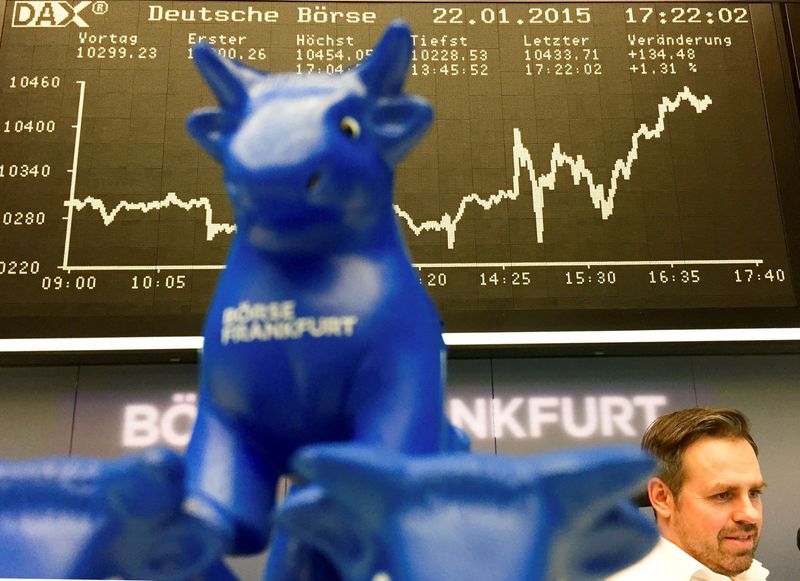Japan records surprise trade deficit in July as exports weaken further
Investing.com - European stocks traded in a mixed fashion Thursday, with investors digesting another flood of quarterly corporate results ahead of the latest policy meeting by the Bank of England.
At 03:05 ET (07:05 GMT), the DAX index in Germany climbed 0.1% and the CAC 40 in France gained 0.3%, while the FTSE 100 in the U.K. fell 0.2%.
There are more quarterly earnings to digest this session, with the second quarter having so far generally offered some relief for investors concerned about the impact of trade uncertainty on corporate performance.
This earnings season is the first to reveal the corporate health impact from U.S. President Donald Trump’s tariff-fueled trade war. Following the EU-U.S. trade deal, analysts have mostly raised their second-quarter earnings growth estimates.
Maersk lifts full-year profit forecast
Shipping group AP Moeller-Maersk (CSE:MAERSKb), a bellwether for global trade, reported second-quarter operating profit above expectations and raised its full-year profit forecast.
Allianz (ETR:ALVG) reported a record operating profit in the second quarter, with the German financial services giant’s results boosted by strong growth in its Property-Casualty segment, which saw higher insurance service results and improved underwriting.
Deutsche Telekom (OTC:DTEGY) lifted its full-year profit guidance even as it reported second quarter core profit in line with expectations, citing continued growth in both Germany and the U.S..
Siemens (ETR:SIEGn) reported industrial profit in line with forecasts for its latest quarter, although the weakening dollar weighed on the German engineering group’s figures.
Rheinmetall (ETR:RHMG) posted slightly weaker-than-expected second-quarter sales due in part to a delay in German defence contracts being awarded, but the German defence company confirmed its full-year forecast.
Bank of England set to cut?
Away from the corporate sector, the Bank of England holds a policy-setting meeting later in the session, and is widely expected to cut interest rates by another quarter point, making it five cuts in the past year.
Investors will be looking for its future guidance given the difficult balance the members have to negotiate between a slowing jobs market and nagging inflation worries.
Data released earlier Thursday showed that Germany’s industrial output fell more than expected in June, dropping 1.9% compared with the previous month, as the positive impact from companies rushing to beat U.S. tariffs waned.
Tariffs remain in spotlight
Investors will also be keeping an eye on the global tariffs landscape, with Trump stating late Wednesday evening, via social media, that his trade tariffs on major economies will take effect from midnight.
Trump last week outlined tariffs ranging from 15% to 50% on several major U.S. trading partners, and earlier Thursday hiked tariffs against India to a cumulative 50%, citing the country’s continued buying of oil from Russia.
The U.S. president also said he would impose a tariff of around 100% on imported semiconductors, though products from companies that build chips within the U.S. would be exempt.
Crude rebounds after weakness
Oil prices rose Thursday, helped by signs of strong U.S. demand, although concerns about the macroeconomic impact of U.S. tariffs and the potential for the return of Russian oil remain.
At 03:05 ET, Brent futures gained 0.7% to $67.33 a barrel, and U.S. West Texas Intermediate crude futures rose 0.7% to $64.81 a barrel.
Crude markets were supported from a bigger-than-expected draw in U.S. crude inventories last week.
The Energy Information Administration said on Wednesday that U.S. crude oil stockpiles fell by 3 million barrels in the week ended August 1, exceeding analysts’ expectations for a relatively small draw.
Both benchmarks had fallen to their lowest in eight weeks on Wednesday, on a five-day losing streak, after Trump indicated progress in talks with Moscow over ending the war with Ukraine, potentially leading to the return of Russian oil to the global market .
Still, despite a more positive tone, the U.S. continues preparations to impose secondary sanctions, including potentially on China, to pressure Moscow to end the war in Ukraine.
